Muck
| Muck Gaelic: Eilean nam Muc | |
 Port Mòr, from the harbour | |
|---|---|
| Main settlement: | Port Mòr |
| Location | |
| Location: | 56°49’48"N, 6°15’0"W |
| Grid reference: | NM408794 |
| Area: | 1,381.3 acre |
| Highest point: | Beinn Airein 449 feet |
| Data | |
| Population: | 30 |
Muck is the smallest of four main islands in the Small Isles, part of the Inner Hebrides. It belongs to Inverness-shire.
Muck measures roughly 2½ miles east to west and has a population of around 30, mostly living near the harbour at Port Mòr. The other settlement on the island is the farm at Gallanach. The island's only road, about a mile and a half long, connects the two.
Geography
A causeway and slipway were built at Port Mòr in 2005. This allows vehicles to be driven on and off the Caledonian MacBrayne ferry, MV Lochnevis, which links Muck and the neighbouring Small Isles of Canna, Rùm and Eigg, with the mainland port of Mallaig (2½ hours away). However, visitors are not normally permitted to bring vehicles to the Small Isles. During the summer months the islands are also served by Arisaig Marine's ferry MV Sheerwater from Arisaig, 10 miles south of Mallaig.
The island's main hill is Beinn Airein (449 feet). Muck is also known for its seal population, and for the porpoises in the surrounding waters. The name of the island may derive from the Gaelic word for porpoise.
The island has an hotel known as Port Mor House.
History
The name of the island, according to James Boswell in 1785, derives from Mouach, signifying the Sows' Island. He relates that the island was formerly "churchland belonging to Icolmkill" and was inhabited by a hermit.[1]
In 1549, Dean Monro wrote:
| “ | Be ane haffe myle of sea to this ile, lyes ane ile of twa myle lang, callit in Erische Ellannaneche, that is the Swynes ile, and very fertill and fruitful of cornes and grassing for all store, and verey guid for fishing, inhabit and manurit, a good falcon nest in it. It perteynis to the Bishope of the iles, with ane guid heighland haven in it, the entrey quherof is at the west cheik.[2] | ” |
Monro also stated of the offshore islet of Eilean nan Each that it was "in Englishe the Horse ile, guid for horse and uther store, perteining to the Bishope of the iles."[2]
In 1773 Samuel Johnson and James Boswell undertook a journey to the Hebrides which Johnson narrated in his book A Journey to the Western Islands of Scotland. He gives an insight into the prosperity on Muck and the philanthropy of its Laird at the time:
| “ | This little Island, however it be named, is of considerable value. It is two English miles long, and three quarters of a mile broad, and consequently contains only nine hundred and sixty English acres. It is chiefly arable. Half of this little dominion the Laird retains in his own hand, and on the other half, live one hundred and sixty persons, who pay their rent by exported corn. What rent they pay, we were not told, and could not decently inquire. The proportion of the people to the land is such, as the most fertile countries do not commonly maintain.
The Laird having all his people under his immediate view, seems to be very attentive to their happiness. The devastation of the small-pox, when it visits places where it comes seldom, is well known. He has disarmed it of its terrour at Muack, by inoculating eighty of his people. The expence was two shillings and sixpence a head. Many trades they cannot have among them, but upon occasion, he fetches a smith from the Isle of Egg, and has a tailor from the main land, six times a year. This island well deserved to be seen, but the Laird's absence left us no opportunity.[3] |
” |
Johnson also reported that the laird of his day resolved to change the name of the island to "Monk" in view of the custom by which lairds would be known not by their name but by the name of their estate, and he did not wish to be known as "Muck". In the event a compromise was reached and the Laird of the island was known in society as "Isle of Muck".
Muck's main landowners today are Lawrence and Ewen McEwen, whose family have owned the island since 1896.[4]
Outside links
References
- Boswell, James; Johnson, Samuel; Carruthers, Robert (1852). The journal of a tour to the Hebrides with Samuel Johnson, LL.D.. Office of the national illustrated Library. http://books.google.com/books?id=5AFOAAAAcAAJ. Retrieved 18 February 2012.
- Haswell-Smith, Hamish (2004). The Scottish Islands. Edinburgh: Canongate. ISBN 1841954543.
- Johnson, Samuel (1792). A Journey to the Western Islands of Scotland. Edinburgh: Lawrie & Symington.
- Monro, Sir Donald (1549) A Description Of The Western Isles of Scotland. Appin Regiment/Appin Historical Society. Retrieved 3 March 2007. First published in 1774.